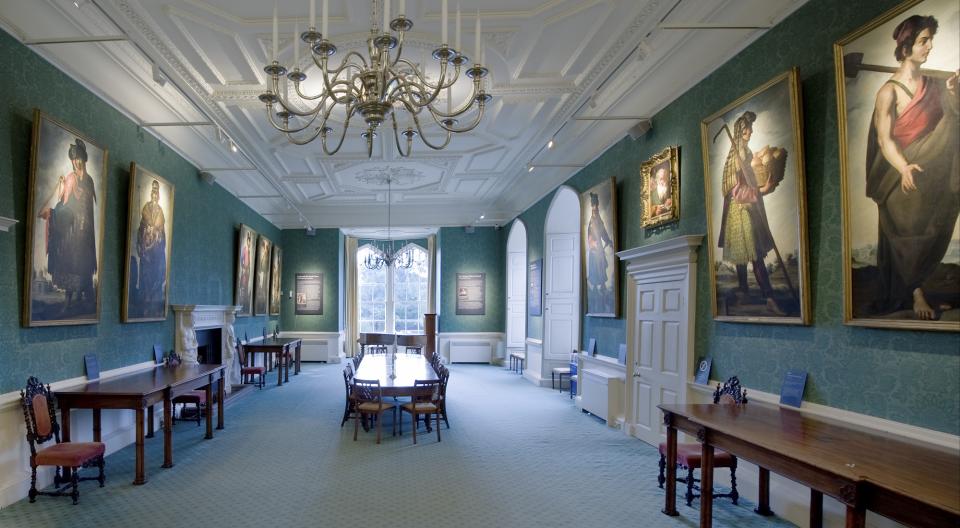
In Spain, the Baroque painter Francisco de Zurbarán is one of the most celebrated painters of the country’s Golden Age. Yet outside his native land, he remains practically unknown. Now, his revered series of works depicting “Jacob and his 12 Sons” is coming to the United States for the first time, with a show at the Meadows Museum in Dallas that is set to travel to the Frick Collection in New York early next year. The event promises to transform Zurbarán’s stature on these shores.
Francisco de Zurbarán, Zebulun. Photograph by Robert LaPrelle © Auckland Castle Trust.
A contemporary of Diego Velazquez, Zurbarán worked primarily for the Monastic institutions of Seville and was known for his religious depictions of Saints and Apostles.
His work is characterized by a combination of striking light-dark contrasts and a rudimentary, slightly makeshift painting style developed during an apprenticeship under an obscure artist in the provinces. Indeed, some art historians view Zurbarán as self-taught.
Francisco de Zurbarán Ruben. Photograph by Robert LaPrelle © Auckland Castle Trust.
In a phone call, senior Frick curator Susan Grace Galassi told artnet News that, far from being a disadvantage, Zurbarán’s unorthodox style actually resonates with contemporary audiences.
“His style is marked by a slightly awkward quality which is really quite appealing. He never totally mastered the anatomy of the human figure or perspective,” she explained. “He was an artist who was very attuned to light-dark contrasts, he had a type of Caravaggio-esque manner, and had a very strong sense of sculptural illusionism in his paintings… I think these are some of the qualities that appeal to people—especially to modern eyes.”
Francisco de Zurbarán Jacob. Photograph by Robert LaPrelle © Auckland Castle Trust.
The works in “Jacob and his 12 Sons” are a visual depiction from Genesis of the blessings of Jacob, bearing all of Zurbarán’s hallmarks. They depict 13 elaborately dressed figures, towering over sumptuous and exotic landscape settings. At six-and-a-half feet by three-and-a-half feet, the paintings also have a uniquely imposing scale.
Francisco de Zurbarán Benjamin. Photograph by Robert LaPrelle © Auckland Castle Trust.
“There’s a great deal to draw one in: the story of these works is a fascinating one, and the works themselves have a great deal of power,” Galsassi said. “The pictures have a legendary status and aura because very little is known of the circumstances in which they were created,” she added. “They’re wrapped in mystery.”
What is known is that the 13 works were created in Seville between 1640 and 1644 and that they were meant to be shipped to Latin America as Catholic propaganda for Spanish missionaries, though they never made it to their intended destination. Nothing was known about the works’ whereabouts until they turned up at auction in London in the 1720s.
In the absence of facts, some colorful stories have emerged, including one theory that they were seized en-route by British pirates and brought to England—though this fanciful tale has now been debunked.
Francisco de Zurbarán Gad. Photograph by Robert LaPrelle © Auckland Castle Trust.
In London they were bought by a Jewish merchant who owned them until his death in 1756 when they were snapped up in a posthumous property auction by the Bishop of Durham, Richard Trevor, a supporter of Jewish emancipation who displayed them at his official residence at Auckland Castle.
According to a catalogue essay by Auckland Castle’s curatorial, conservation, and exhibitions director, Dr. Christopher Ferguson, Trevor purchased the works at a time when “Jews and dissenting non-Anglican Christians in Britain were treated with indifference, if not contempt.” The series, he says, “was brought to Auckland Castle as a plea for religious tolerance and social equality.”
Francisco de Zurbarán Asher. Photograph by Robert LaPrelle © Auckland Castle Trust.
Thanks to renovation work at Auckland Castle, the complete series of 13 works is coming to the US for the first time, both to undergo analysis and to go on display. Prior to coming to their display in Dallas each of the paintings underwent an x-ray and infrared reflect-graphy examination at the Kimbell Art Museum in Fort Worth at the hands of the leading conservator Claire Barry. Over the course of the analysis Barry and her team identified certain aspects of the artist’s painting process that were typically Zurbarán to help identify the master’s hand within the paintings, and in future analysis.
For instance, the team discovered that Zurbarán primed his canvases with light and dark underpainting, indicating that he worked out the composition before he started painting. They also found that Zurbarán looked to prints and other sources for inspiration on details such as costumes.
Francisco de Zurbarán Joseph. Photograph by Robert LaPrelle © Auckland Castle Trust.
The biggest mystery of all might be why Zurbarán hasn’t become a household name. Galassi explained that even in Spain, he wasn’t recognized as early as El Greco, Velazquez, or Murillo. And his paintings didn’t come to the US as early as others.
Whereas Americans started collecting his contemporaries in the late 19th and early 20th century, they didn’t begin importing Zurbarán until the 1920s. Even though today the US has more Zurbarán paintings than any other country outside Spain, relatively few people recognize his name. The show of “Jacob and his 12 Sons” promises to change that.
“Zurbarán: Jacob and His Twelve Sons, Paintings from Auckland Castle” is on view at the Meadows Museum in Dallas through January 7, 2018. It travels to the Frick Collection in New York, January 31-April 22, 2018.